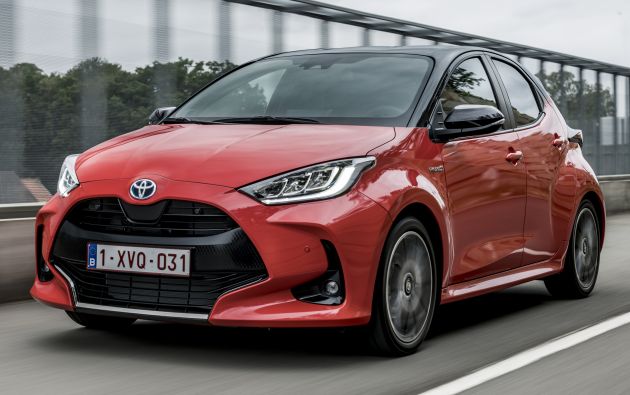2020 Toyota Yaris detailed for Europe – 125 PS petrol and 116 PS hybrid with 1.5 litre NA three-cylinder
Toyota has finally released full details of the new Yaris for the European market. The B-segment hatchback has yet to go on sale on the Continent more than nine months after it was revealed (and more than five months after it was offered in Japan), but the carmaker appears to be ready to divulge all kinds of information.
At last, it’s also given us details of the engines on offer. Just like in Japan, the Yaris is being sold in Europe in two variants featuring the 1.5 litre Dynamic Force three-cylinder engine, which continues to eschew turbocharging in favour of natural aspiration, direct injection and VVT-iW.
Pure petrol variants push out 125 PS at 6,600 rpm and 153 Nm of torque from 4,800 to 5,000 rpm and are mated to either a six-speed manual gearbox or a CVT with a physical first gear. Fuel consumption is rated on the NEDC cycle at 5.1 litres per 100 km combined with the manual and 4.9 litres per 100 km with the CVT.
Meanwhile, the Hybrid model’s Atkinson-cycle mill makes a bit less power – 92 PS and 120 Nm, to be exact – but it’s augmented by twin motors that generate 59 kW (80 PS) and 141 Nm, delivering a total system output of 116 PS. That’s 16% higher than before, allowing a 15% improvement in the zero-to-100 km/h stakes, now completed in 9.7 seconds.
The engine’s long stroke, high 14:1 compression ratio and high-speed combustion (with better temperature and pressure control) contribute to a thermal efficiency of 40%. As such, the car’s fuel consumption is 20% lower at 3.2 litres per 100 km. The Yaris Hybrid can also travel further on electric power mode alone and can do so at speeds of up to 130 km/h, thanks to a smaller, lighter, yet higher-density lithium-ion battery.
Certain markets will also receive a 72 PS/93 Nm 1.0 litre naturally-aspirated three-pot to lower the starting price, mated to a five-speed manual. This one uses a bit less fuel than the larger, more powerful petrol mill, at 4.1 litres per 100 km combined. Of course, there’s also the ultra-hot, all-wheel-drive GR Yaris, but that is an entirely different car.
As previously reported, the Yaris will ride on the B variant of the Toyota New Global Architecture (GA-B), giving the car a lower centre of gravity and a 37% increase in torsional rigidity. It’s five millimetres shorter than before, sitting under the four-metre mark, but the wheelbase has been extended some 50 mm to provide extra cabin space. The new platform has also allowed a 40 mm drop in height, while the width has been increased by 50 mm and the track by 57 mm to give the car a broader stance.
Toyota says the Yaris expresses “energy and dynamism” in its design and it certainly looks that way. The large front grille, sweptback headlights, longer bonnet, upswept beltline and full-width tail lights give the car a distinctly sportier look than before, accentuated by the available two-tone paint scheme. The wheel options measure between 15 and 17 inches in diameter.
Inside, the cabin has been thoroughly modernised with a de rigueur eight-inch floating touchscreen, a wider centre console and a sporty small-diameter steering wheel. Perceived quality has been increased through the greater use of soft-touch plastic on the dashboard and felt inserts for the door panels, while the lower dashboard and the more rearwards positioning of the A-pillars improve forward visibility.
The driving position has also been improved, with the seat now positioned 60 mm further rearward and 21 mm lower; the more vertical steering wheel can also be brought 77 mm closer to the driver. The front seats have also been positioned further outboard to increase space between driver and passenger.
Additionally, the driving environment has been enhanced with a “binocular” instrument cluster and an optional head-up display. All models feature wireless Apple CarPlay and Android Auto as standard, with a Qi wireless charger, an eight-speaker JBL sound system and blue ambient lighting available as options.



Safety-wise, the Yaris is the first Toyota to come with centre airbags. The full complement of Toyota Safety Sense features, which include autonomous emergency braking (with pedestrian, cyclist and oncoming vehicle detection), emergency steering assistance, adaptive cruise control, traffic sign recognition, lane keeping assist, lane centring assist and automatic high beam is also fitted as standard.
Under the skin, the Yaris’ suspension setup has been optimised for better driving dynamics. The MacPherson struts at the front are set at a revised angle, which reduces friction and allows for better alignment between the dampers and springs, lowering vibration. The rear torsion beam has also been stiffened by 80% with a corresponding increase in roll stiffness, allowing for softer, more comfortable springs to be fitted.
With the more rigid bodyshell and a lower centre of gravity, Toyota claims the Yaris offers superior handling and responsiveness, increased stability, better ride comfort and improved weight distribution, while the redesigned dashboard and floor panels and increased body sealing help drive out noise and vibration. The Yaris also a boasts best-in-class turning circle of just 4.9 metres.

































































The post 2020 Toyota Yaris detailed for Europe – 125 PS petrol and 116 PS hybrid with 1.5 litre NA three-cylinder appeared first on Paul Tan's Automotive News.
from Paul Tan's Automotive News
Read The Rest:paultan...




.jpg)
Post a Comment